I had motion-controlled lights on my front steps for about a year when I decided I could do better. While it was nice to move up and down the steps without having to hit a light switch, the overhead lights powered by the Insteon Motion Sensor and SwitchLinc just felt like overkill in the middle of the night, no matter how low I dimmed the lights in the motion program.
Inspired by the indirect lighting in movie theaters, I went looking for other options and finally discovered this little gem: a 16 foot reel of flexible, bright LED lights. These things are awesome, and have all kinds of uses in the automated home. They even come with an adhesive backing to stick them wherever you want – under counters, on stairs, and even inside drawers and cabinets. I decided to apply them under the handrail on my steps to provide motion-activated light at night:
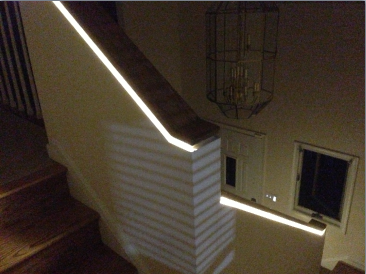
There were quite a few challenges around how to power and control these, which I’ll cover in future posts, but as you can see in the above picture, the first challenge I had was that there wasn’t a contiguous run of railing to follow, so I had to come up with a way to cleanly break between segments of railing. The trick was to run wires inside the drywall:
- It is easy enough to stick the lights under that lip, and solder
a wire between the segments. But since you didn’t want the wire to be exposed, start by scoring the drywall between segments:
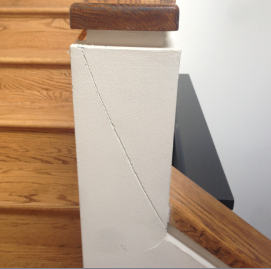
- Continue to expand the hole until you can fit the connected wire into the routed hole:

- Liberally apply spackle
over the wire, filling in the hole:
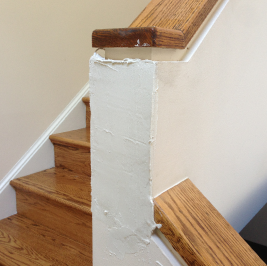
- Sand and paint, applying the same techniques we covered in the drywall post:
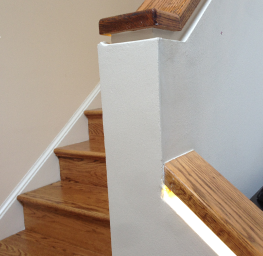
- That’s it! The end result is a nice clean look without exposed wires:
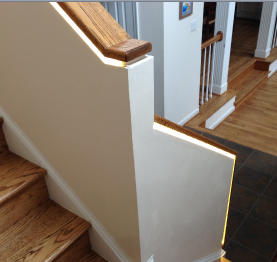
You could even potentially use a strip of colored lights if you want to be able to get a little more creative – or use different colors depending on the holiday mood.
Stay tuned for two different options on how to power and control these lights – one wirelessly, and one wired into our Insteon system.



I hope to do some of these Matt. Just need a house – and the time! Steve
Hi Matt,
Do you have some sort of diffused enclosure you are using for the LED strips? I have plenty of LED strips but i don’t like being able to see the physical LED’s instead of seeing one illuminated strip. Great Blog
Thanks, Justin
Justin, good question! I’m actually actively looking into options for another project (some counter-top lighting using a similar approach as this project) and have started exploring some options, such as using translucent hot glue or shower caulk to fill in a groove that contains the lights. I’ll update once I find a decent option.
That said, for this particular project, because the lights were attached to the bottom of the lip, the lights themselves aren’t actually visible, and the light is very consistent going down the stairs.